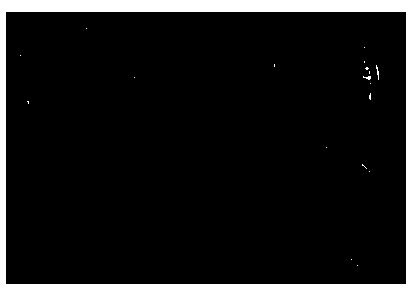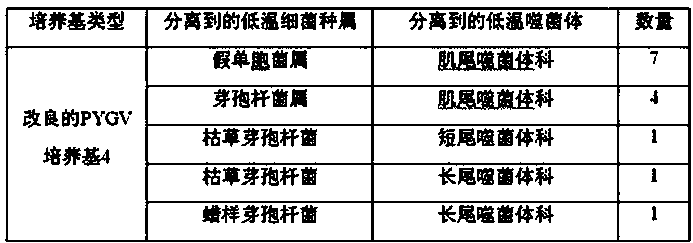Method for efficiently screening low-temperature bacteriophages
A phage, low-temperature technology, applied in the field of efficient screening of low-temperature phage, can solve the problem of consuming a lot of time, and achieve the effects of improving efficiency, saving culture space, and saving costs
- Summary
- Abstract
- Description
- Claims
- Application Information
AI Technical Summary
Problems solved by technology
Method used
Image
Examples
Embodiment 1
[0032] Example 1 : The improved PYGV culture medium screens and isolates the method for low-temperature phage, and the specific contents are as follows:
[0033] (1) Isolation of low-temperature host bacteria: The soil or water samples collected from the Napahai Wetland in Yunnan Province were used to separate different low-temperature bacteria by the dilution plate method at 15°C using the solid-modified PYGV medium. Colony, as a possible host bacterium, pick a single colony with a sterile inoculation loop, inoculate it in the modified liquid PYGV medium, and cultivate it at 15°C and 150rpm for 16h until the concentration of the host bacterium reaches about 10 8 CFU / ml;
[0034] (2) Preparation of phage enrichment solution
[0035] The soil or water samples collected from the Napahai Wetland in Yunnan Province were added to the improved liquid PYGV medium (10g of soil samples were added to 100ml of medium, and 10ml of water samples were added to 100ml of medium), and pla...
Embodiment 2
[0046] Example 2 : The improved PYGV culture medium screens and isolates the method for low-temperature phage, and the specific contents are as follows:
[0047] (1) Isolation of low-temperature host bacteria: The soil samples or water samples collected from the Napahai Wetland in Yunnan Province were used to separate different low-temperature bacteria by the dilution plate method at 20°C using the solid-modified PYGV medium, and the single bacteria were obtained by streaking. Colony, as a possible host bacterium, pick a ring of colonies with a sterile inoculation loop, inoculate in liquid PYGV medium, cultivate at 10°C, 150rpm for 18h, until the concentration of the host bacterium reaches about 10 7 CFU / ml;
[0048] (2) Preparation of phage enrichment solution
[0049] The soil or water samples collected from the Napahai Wetland in Yunnan Province were added to the improved liquid PYGV medium (8g of soil samples were added to 100ml of medium, and 8ml of water samples wer...
Embodiment 3
[0059] Example 3 : The improved PYGV culture medium screens and isolates the method for low-temperature phage, and the specific contents are as follows:
[0060] (1) Isolation of low-temperature host bacteria: Soil or water samples collected from the Napahai Wetland in Yunnan Province were used to isolate different low-temperature bacteria at 28°C by using solid-modified PYGV medium as possible hosts. Bacteria, pick a ring of colonies with a sterile inoculation loop, inoculate in the modified liquid PYGV medium, and cultivate at 20°C, 150rpm for 12h, until the concentration of the host bacteria reaches about 10 8 CFU / ml;
[0061] (2) Preparation of phage enrichment solution
[0062] Add the soil or water samples collected from the Napahai Wetland in Yunnan Province to the liquid PYGV medium (10g of soil samples are added to 100ml of medium, and 10ml of water samples are added to 100ml of medium), and placed at 10°C Place in culture for 1-2 weeks, absorb the enrichment so...
PUM
 Login to View More
Login to View More Abstract
Description
Claims
Application Information
 Login to View More
Login to View More - R&D
- Intellectual Property
- Life Sciences
- Materials
- Tech Scout
- Unparalleled Data Quality
- Higher Quality Content
- 60% Fewer Hallucinations
Browse by: Latest US Patents, China's latest patents, Technical Efficacy Thesaurus, Application Domain, Technology Topic, Popular Technical Reports.
© 2025 PatSnap. All rights reserved.Legal|Privacy policy|Modern Slavery Act Transparency Statement|Sitemap|About US| Contact US: help@patsnap.com



